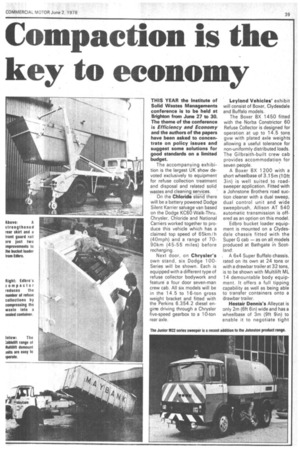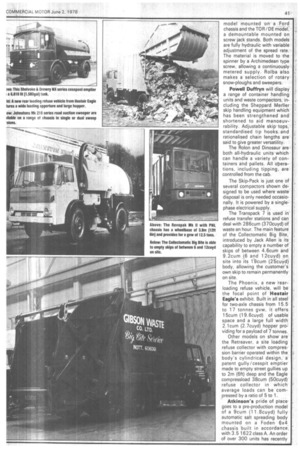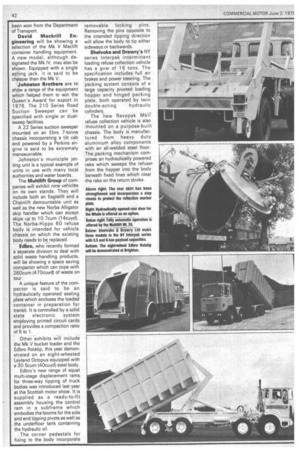Compaction is the key to economy
Page 41

Page 42

Page 43

Page 44

If you've noticed an error in this article please click here to report it so we can fix it.
THIS YEAR the Institute of Solid Wastes Managements conference is to be held at Brighton from June 27 to 30. The theme of the conference is Efficiency and Economy and the authors of the papers have been asked to concentrate on policy issues and suggest some solutions for good standards on a limited budget.
The accompanying exhibition is the largest UK show devoted exclusively to equipment for refuse collection treatment and disposal and related solid wastes and cleaning services.
On the Chloride stand there will be a battery powered Dodge Silent Karrier salvage van based on the Dodge KC60 Walk-Thru. Chrysler, Chloride and National Carriers worked together to produce this vehicle which has a claimed top speed of 65km / h (40mph) and a range of 7090km (45-55 miles) before recharging.
Next door, on Chrysler's own stand, six Dodge 100Series will be shown. Each is equipped with a different type of refuse collector bodywork and feature a four door seven-man crew cab. All six models will be in the 14.5 to 16-ton gross weight bracket and fitted with the Perkins 6.354.2 diesel engirlie driving through a Chrysler five-speed gearbox to a 10-ton rear axle. Leyland Vehicles' exhibit will consist of Boxer. Clydesdale and Buffalo models.
The Boxer BX 1450 fitted with the Norba Constrictor 60 Refuse Collector is designed for
operation at up to 14.5 tons. gvw with plated axle weights allowing a useful tolerance for non-uniformly distributed loads. The Gilbraith-built crew cab provides accommodation for seven people.
A Boxer BX 1200 with a short wheelbase of 3.15m (10ft 3in) is well suited to roadsweeper application. Fitted with a Johnstone Brothers road suction cleaner with a dual sweep, dual control unit and wide sweepbrush, Allison AT 540 automatic transmission is offered as an option on this model.
Edbro bucket loader equipment is mounted on a Clydesdale chassis fitted with the Super G cab — as on all models produced at Bathgate in Scotland'.
A 6x4 Super Buffalo chassis, rated on its own at 24 tons or with a drawbar trailer at 32 tons, is to be shown with Multilift ML 14 demountable body equipment. It offers a full tipping capability as well as being able to transfer containers onto a drawbar trailer.
Hestair Dennis's Alleycat is only 2m (6ft 6in) wide and has a wheelbase of 3m (9ft 9in) to enable it to negotiate tight corners and entrances. The latest addition to the Dennis range is the Mini Bulkmaster. With intermittent packing mechanism and ejection discharge, it will accommodate over 9.2cum (12cuyd) of refuse. At 2.1m (7ft) wide it is narrower than the Bulkmaster II already in service.
A Bulkmaster 50 is a smaller version of the 70 offering a body space of 11.0cum (14.5cuyd) as opposed to 13.1cum (17.25cuyd).
Whale's combination tanker made its first public appearance in the West Midlands District Council livery, one of the first municipal authorities to specify this Continental-type tanker.
A gully arm further extends the capabilities of the Jetvac, a dual-purpose tanker which is basically a cesspool emptier equipped with a clean water tank and a very high-pressure water pump and long hose on an hydraulic reel.
This Continental system is claimed to give good performance at low cost, enabling authorities with only occasional needs to have their own jettingand gully emptying equipment without having a chassis standing idle for long periods. Equipment includes a 6,810litre (1,500gal) tank a 408curn /h (240cuft / min) exhauster, a WOMA 252 high pressure pump and hydraulically operated main hose reel.
The tank is separated into a clean water section of 2,270 litres (500gal) and 4,540 litres (100gal) for sludge, with a fourclamp fully opening door and pneumatically assisted gully arm.
A range of compaction containers made from high-tensile steel, designed to withstand greater pressures than the most powerful compactor is able to exert, will be announced by Skip Units.
These containers are said to suit all proprietary makes of demountable frame. The base is made in a single piece of 5mm (3/16in) steel sheet completely free of joints. The same stand will include a series of covered containers specifically designed for use with the Jack Allen Big Bite refuse collector. The system will allow handling without needing to be turned around, saving operational time. _ .
kip UnitsFriakes a wide range of skip containers and demountable open bodies in capacities up to .38.25cum (50cuyd).
Rolba bulk g r itters will be shown in two forms — the TOR / DS permanently fitted
model mounted on a .Ford chassis and the TOR/DE mOdel, a demountable mounted on screw jack stands. Both models are fully hydraulic with variable adjustment of the spread rate. The material is moved to the spinner by a Archimedean type screw, allowing a continuously metered supply. Rolba also makes. a selection of rotary snow-ploughs and sweepers.
Powell Duffryn will display a range of container handling units and waste compactors, including the Sheppard Merller skip handling equipment which has been strengthened and shortened to aid manoeuvrability. Adjustable skip tops, standardised tip hooks and rationalised chain lengths are said to give greater versatility.
The Rolon and Dinosaur are both all-hydraulic units which can handle a variety of containers and pallets. All 'operations, including tipping, are controlled from the cab.
The Skip-Pack is just one of several compactors shown designed to be used where waste disposal is only needed occasionally. It is powered by a singlephase electrical supply.
The Transpack 7 is used in refuse transfer stations and can deal with 286curri (370cuyd) of waste an hour. The main feature of the Collectomatic Big Bite, introduced by Jack Allen is its capability to empty a number of skips of between 4.6cum and 9.2cum .(6 and 12cuyd) on site into its 1-9curn (25Cuy-c1)" body, allowing the customer's own skip to remain permanently on site.
The Phoenix, a new rearloading refuse vehicle, will be the focal point of Hestair Eagle's exhibit. Built in all steel for two-axle chassis from 15.5 to 17 tonnes gvw, it offers 15cum (19.6cuyd) of usable space and a large full width 2.1cum (2.7cuyd) hopper providing for a payload of 7 tonnes.
Other models on show are the Retreaver, a site loading refuse collector with compression barrier operated within the body's cylindrical design, a patent gully/cesspit emptier made to empty street gullies up to 2m (6ft) deep and the Eagle compressload 38cum (50cuyd) refuse collector in which average loads can be com pressed by a ratio of 5 to 1. _
Atkinson's pride of place goes to a pre-production model of a 9cum (11.8cuyd) fully automatic salt spreading body mounted on a Foden 6x4, chassis built in accordance; with 3.5 1622 class A. An order of over 300 units has recently
been won from the Department of Transport.
David Mackrill Engineering will be showing a selection of the Mk V Maclift container handling equipment. A new model, although designated the Mk IV, may also be shown. Equipped with a single acting jack, it is said to be cheaper than the Mk V.
Johnston Brothers are to show a range of the equipment which helped them to win the Queen's Award for export in 1976. The 210 Series Road' Suction Sweeper can be specified with single or dualsweep facilities.
A 22 Series suction sweeper mounted on an Ebro 7-tonne chassis incorporating a tilt cab and powered by a Perkins engine is said to be extremely manoeuvrable.
Johnston's municiple jetting unit is a typical example of units in use with many local authorities and water boards.
The Multilift Group of companies will exhibit nine vehicles on its own stands. They will include both an Eaglelift and a Chainlift demountable unit as well as the new Norba Alligator skip handler which can accept skips up to 10.7cum (14cuyd). The Norba-Hippo 60 refuse body is intended for vehicle chassis on which the existing body needs to be replaced.
Edbro, who recently formed a separate division to deal with solid waste handling products, will be showing a space saving compactor which can cope with 260cum (470cuyd) of waste on tour.
A unique feature of the compactor is said to be an hydraulically operated sealing plate which encloses the loaded container in preparation for transit. It is controlled by a solid state electronic system employing printed circuit cards and provides a compaction ratio of 6 to 1.
Other exhibits will include the Mk V bucket loader and the Edbro Rolatip, this year demonstrated on an eight-wheeled Leyland Octopus equipped with a 30.5cum (40cuyd) steel body.
Edbro's new range of squat multi-stage displacement rams for three-way tipping of truck bodies was introduced last year at the Scottish motor show. It is supplied as a ready-to-fit assembly housing the control ram in a subframe which embodies the booms for the side and end tipping pivots as well as the underfloor tank containing the hydraulic oil.
The corner pedestals for fixing to the body incorporate removable locking pins. Removing the pins opposite to the intended tipping direction will allow the body to tip either sideways or backwards.
Shelvoke and Drewry's NY series lnterpak intermittent loading refuse collection vehicle has a gvw of 16 tons. The specification includes full air brakes and power steering. The 'packing system consists of a large capacity pivoted loading hopper and hinged packing plate, both operated by twin double-acting hydraulic cylinders.
The 'hew Revopak MI(11 refuse collection vehicle is also mounted on a purpose-built chassis. The body is manufactured from heavy duty aluminium alloy components with an all-welded steel floor. The _packing mechanism comprises an hydraulically powered rake which sweeps the refuse, from the hopper into the body beneath fixed lines which clear the rake on the return stroke.








































































































































